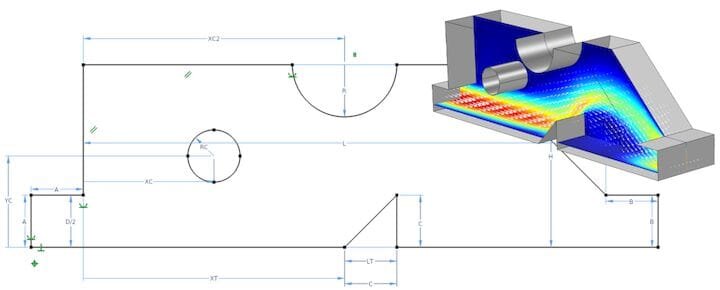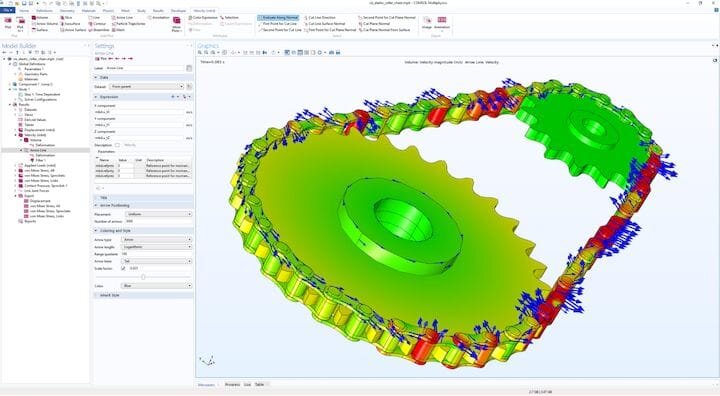 Analysis of an elastic chain drive in COMSOL Multiphysics 5.5’s Multibody Dynamics Module. (Image courtesy of COMSOL.)
Analysis of an elastic chain drive in COMSOL Multiphysics 5.5’s Multibody Dynamics Module. (Image courtesy of COMSOL.)
This November, simulation provider COMSOL will release the latest version of its multiphysics analysis software, COMSOL Multiphysics 5.5.
We got a sneak preview of the new release last week in Boston at the 15th annual COMSOL Conference.
“We don’t have any revolutionary things to release this time, but we have a lot of evolutionary things,” commented COMSOL CEO Svante Littmarck in the conference’s keynote demonstrating version 5.5. An odd thing to say about a new release, especially one that, by any measure, is full of new features and improvements. COMSOL CTO Ed Fontes later clarified the philosophy behind the CEO’s words.
“You try to meet the customer’s needs by observing what they want. But you look at what they do, and what they’re trying to do, and you come up with completely different ways of doing it. That’s what Svante would call revolutionary. Evolutionary is when they tell you improvements to what you already have. And we do both of those.”
So even though Multiphysics 5.5 isn’t what Littmarck would consider revolutionary, it’s nonetheless a feature-packed release. Let’s unpack it.
Shape and Topology Optimization
In Multiphysics 5.4, released last year, COMSOL enhanced shape and topology optimization in the Optimization Module. The decision wasn’t based on user demand. Rather, Fontes admitted, it was opportunism. COMSOL had recently acquired whiz kid Kristian Ejlebjærg Jensen from the Danish School of Optimization and was eager to make use of his expertise.
With Jensen at the helm, Fontes considers the Optimization Module to be the fastest growing of the 20 or so Multiphysics modules available. In release 5.5, shape optimization setup has been simplified, making it easier for users to perform optimization studies. Moving boundaries are now parametrized by polynomials, and there’s built-in support for shell thickness optimization. Topology optimization has a new smoothing operation for better geometry outputs, as well as an improved under-the-hood treatment of removed elements.
In Jensen’s opinion, the improvements will increase the number of users taking advantage of the Optimization Module. “We have made it easier to do the post-processing,” he said. “We have some easier workflows and it’s more robust for taking the optimization result and making a real geometry representation out of it.”
 Shape optimization of a sheet metal bracket in COMSOL Multiphysics 5.5’s Optimization Module. (Image courtesy of COMSOL.)
Shape optimization of a sheet metal bracket in COMSOL Multiphysics 5.5’s Optimization Module. (Image courtesy of COMSOL.)
More Modules Evolve
Though Optimization may be the fastest growing module, it’s not the only module with improvements in 5.5. The Structural Mechanics Module, Nonlinear Structural Materials Module, and Composite Materials Module all benefit from new nonlinear analysis options for shells and composite shells. Depending on the module, these include plasticity, creep, viscoplasticity, viscoelasticity, hyperelasticity and mechanical contact, which now supports any combination of solids and shells.
A big update has come to the Design Module in the form of a new parametric sketching tool with dimensioning. Now, users can create parametrized 2D drawings directly within Multiphysics 5.5. The interface resembles the sketching tools available in any CAD software, with dimensions and constraints like parallel, perpendicular, coincident and so on.
“The new tools for dimensions and constraints can be used together with model parameters in COMSOL Multiphysics to drive the simulation, whether for a single run, parametric sweep, or parametric optimization,” said COMSOL’s Daniel Bertilsson.
 Parametrized sketch of a Tesla valve in COMSOL Multiphysics 5.5. (Image courtesy of COMSOL.)
Parametrized sketch of a Tesla valve in COMSOL Multiphysics 5.5. (Image courtesy of COMSOL.)
Here are a few more of the modular improvements:
-
Structural Mechanics Module: A new user interface for pipe mechanics allows users to analyze stress on pipe systems, including external loads, internal pressure, axial drag forces, and temperature gradients through the pipe wall. Also new is the ability to perform random vibration analysis.
-
CFD Module: Has new user interfaces for compressible Euler flow and nonisothermal large eddy simulations, as well as new support for the flow interfaces of rotating machines.
-
Heat Transfer Module: Has a new interface for lumped thermal systems and now supports multiple spectral bands for radiation in semitransparent media. Convective flow should solve 30 percent faster thanks to a new open boundary formulation.
-
Ray Optics Module: Can now combine with the RF and Wave Optics Modules for multiscale modeling.
-
AC/DC Module: Can now combine with the Composite Materials Module to analyze layered materials in thin structures.
-
RF Module: Enables easier setup with a set of new ports for vias and transmission lines.
-
Multibody Dynamics Module: Can now automatically generate the many links and joints needed for modeling rigid and elastic chain drives.
-
Acoustics Module: New solver technology for acoustics simulations allows users to analyze higher frequencies with the finite element method, as well as efficiently compute ultrasound propagation in solids and fluids. The new technology will also benefit the Structural Mechanics and MEMS Modules.
Read more at ENGINEERING.com

